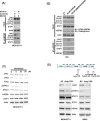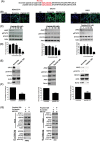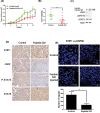Stress-induced phosphoprotein-1 maintains the stability of JAK2 in cancer cells
- PMID: 27409672
- PMCID: PMC5226602
- DOI: 10.18632/oncotarget.10500
Stress-induced phosphoprotein-1 maintains the stability of JAK2 in cancer cells
Abstract
Overexpression of stress-induced phosphoprotein 1 (STIP1) - a co-chaperone of heat shock protein (HSP) 70/HSP90 - and activation of the JAK2-STAT3 pathway occur in several tumors. Combined treatment with a HSP90 inhibitor and a JAK2 inhibitor exert synergistic anti-cancer effects. Here, we show that STIP1 stabilizes JAK2 protein in ovarian and endometrial cancer cells. Knock-down of endogenous STIP1 decreased JAK2 and phospho-STAT3 protein levels. The N-terminal fragment of STIP1 interacts with the N-terminus of JAK2, whereas the C-terminal DP2 domain of STIP1 mediates the interaction with HSP90 and STAT3. A peptide fragment in the DP2 domain of STIP1 (peptide 520) disrupted the interaction between STIP1 and HSP90 and induced cell death through JAK2 suppression. In an animal model, treatment with peptide 520 inhibited tumor growth. In summary, STIP1 modulates the function of the HSP90-JAK2-STAT3 complex. Peptide 520 may have therapeutic potential in the treatment of JAK2-overexpressing tumors.
Keywords: JAK2; STIP1; cancer.
Conflict of interest statement
The authors declare no conflicts of interest.
Figures







Similar articles
-
JAK2-Mediated Phosphorylation of Stress-Induced Phosphoprotein-1 (STIP1) in Human Cells.Int J Mol Sci. 2022 Feb 22;23(5):2420. doi: 10.3390/ijms23052420. Int J Mol Sci. 2022. PMID: 35269562 Free PMC article.
-
Stress-induced phosphoprotein 1 facilitates breast cancer cell progression and indicates poor prognosis for breast cancer patients.Hum Cell. 2021 May;34(3):901-917. doi: 10.1007/s13577-021-00507-1. Epub 2021 Mar 4. Hum Cell. 2021. PMID: 33665786
-
Stress-induced phosphoprotein 1 mediates hepatocellular carcinoma metastasis after insufficient radiofrequency ablation.Oncogene. 2018 Jun;37(26):3514-3527. doi: 10.1038/s41388-018-0169-4. Epub 2018 Mar 21. Oncogene. 2018. PMID: 29559743
-
HSP90 inhibitor NVP-AUY922 enhances TRAIL-induced apoptosis by suppressing the JAK2-STAT3-Mcl-1 signal transduction pathway in colorectal cancer cells.Cell Signal. 2015 Feb;27(2):293-305. doi: 10.1016/j.cellsig.2014.11.013. Epub 2014 Nov 18. Cell Signal. 2015. PMID: 25446253 Free PMC article.
-
Stress-induced phosphoprotein 1: how does this co-chaperone influence the metastasis steps?Clin Exp Metastasis. 2024 Oct;41(5):589-597. doi: 10.1007/s10585-024-10282-6. Epub 2024 Apr 6. Clin Exp Metastasis. 2024. PMID: 38581620 Review.
Cited by
-
STAT3 Interactors as Potential Therapeutic Targets for Cancer Treatment.Int J Mol Sci. 2018 Jun 16;19(6):1787. doi: 10.3390/ijms19061787. Int J Mol Sci. 2018. PMID: 29914167 Free PMC article. Review.
-
Glucose Activates Lysine-Specific Demethylase 1 through the KEAP1/p62 Pathway.Antioxidants (Basel). 2021 Nov 26;10(12):1898. doi: 10.3390/antiox10121898. Antioxidants (Basel). 2021. PMID: 34942999 Free PMC article.
-
Glycogen synthase kinase-3 beta (GSK3β)-mediated phosphorylation of ETS1 promotes progression of ovarian carcinoma.Aging (Albany NY). 2021 May 23;13(10):13739-13763. doi: 10.18632/aging.202966. Epub 2021 May 23. Aging (Albany NY). 2021. PMID: 34023818 Free PMC article.
-
Retrospective Proteomic Screening of 100 Breast Cancer Tissues.Proteomes. 2017 Jul 7;5(3):15. doi: 10.3390/proteomes5030015. Proteomes. 2017. PMID: 28686225 Free PMC article.
-
Adapting to stress - chaperome networks in cancer.Nat Rev Cancer. 2018 Sep;18(9):562-575. doi: 10.1038/s41568-018-0020-9. Nat Rev Cancer. 2018. PMID: 29795326 Free PMC article. Review.
References
-
- Odunuga OO, Longshaw VM, Blatch GL. Hop: more than an Hsp70/Hsp90 adaptor protein. Bioessays. 2004;26:1058–1068. - PubMed
-
- Carrigan PE, Riggs DL, Chinkers M, Smith DF. Functional comparison of human and Drosophila Hop reveals novel role in steroid receptor maturation. J Biol Chem. 2005;280:8906–8911. - PubMed
-
- Scheufler C, Brinker A, Bourenkov G, Pegoraro S, Moroder L, Bartunik H, Hartl FU, Moarefi I. Structure of TPR domain-peptide complexes: critical elements in the assembly of the Hsp70-Hsp90 multichaperone machine. Cell. 2000;101:199–210. - PubMed
MeSH terms
Substances
LinkOut - more resources
Full Text Sources
Other Literature Sources
Research Materials
Miscellaneous

